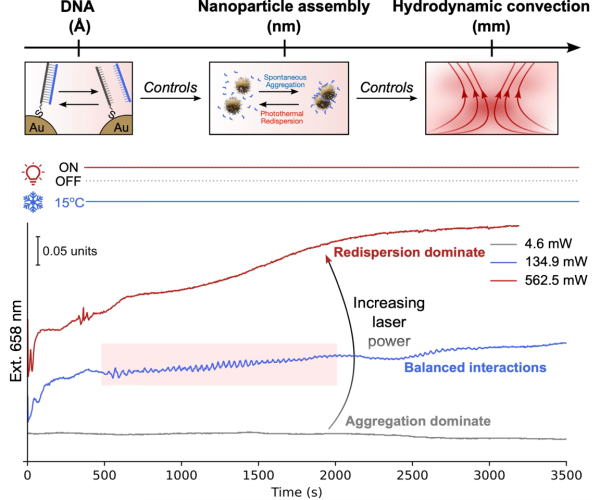Gold Nanoparticles Dance to the Beat of Light
In this work, the team developed a DNA-coated gold nanoparticle system that exhibits oscillatory hydrodynamic flows in response to non-periodic light. The system uses hierarchical feedback loops and thermal hysteresis to create self-oscillating patterns, offering a new approach to nanoscale dynamic behaviors with potential applications in light-powered technology and machinery.
Original publication: Choreographing Oscillatory Hydrodynamics with DNA-Coated Gold Nanoparticles

Figure: Thermosensitive hybridization of DNA-based ligands controls the reversible assembly of nanoparticles, setting conditions for oscillatory convection at the macro scale. The oscillations originate from temperature-dependent changes in the buoyancy of the dispersion, leading to organized convective flows.
Just like a heart beating rhythmically, living things often show repeating patterns in response to steady inputs. Such a rhythmic behaviours found in nature remains a challenge for synthetic systems.
A group of researchers led by Marek Grzelczak have engineered a novel nanosystem using DNA-coated gold nanoparticles that exhibits oscillatory hydrodynamic flows when exposed to a continuous, non-periodic light source. This behaviour arises from a hierarchical response where light-induced heating triggers reversible DNA hybridisation, leading to nanoparticle aggregation and dispersion. The system employs slow aggregation as positive feedback and rapid photothermal disassembly as negative feedback, with thermal hysteresis introducing a crucial time delay. This combination of asymmetric feedback loops and time delay orchestrates the observed oscillating patterns in the nanoparticle dispersion, demonstrating a unique approach to creating self-oscillating systems at the nanoscale.
These findings demonstrate that a hierarchical design, where molecular interactions at the nanoscale govern nanoparticle assembly, can be translated into millimetre-scale oscillating fluid flows. From a broader perspective, this work shows how simple components at the nanoscale can be programmed to create complex, dynamic behaviours, mimicking some of the rhythmic phenomena seen in living systems. By understanding and controlling self-oscillating systems, one can potentially develop new technologies, for example, in light-powered pumps and machinery.



